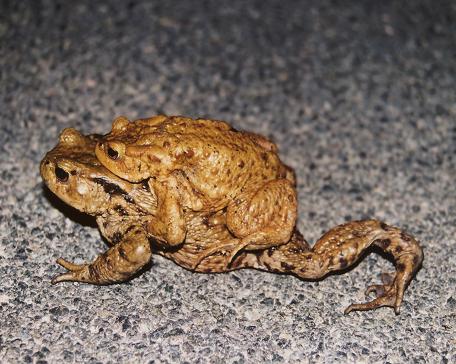


|
Bufonidae :
This group is large and very complicated. Bufonidae is composed of 33 genera with a cosmopolitan distribution, except for Australia where the only Bufonid is the introduced Cane Toad (Bufo marinus), which has become a pest and danger to local wildlife (with recent studies showing its pronounced negative effects on Australian snakes) due to its voracious appetite, large size, high fecundity, and high toxicity. This family includes the stereotypical “toad” with shortened forelimbs and hind limbs used for walking or hopping, dry warty skin, and parotoid glands behind eyes. Development in this group is as varied as that for Ranids; there are species that lay eggs in water and produce aquatic larvae, terrestrial direct developers, and viviparous species (Nectophrynoides and Mymbaphrynoides). Characters shared within the family are: 1) bidder’s organ present; 2) teeth absent from upper and lower jaws; 3) constrictor posterior muscle absent; 4) depressor mandibulae muscle originating solely from squamosal; 5) inguinal fat bodies present; 6) skull highly ossified (usually skin is ossified to the skull).
Genus :
Adenomus (3 species)
Altiphrynoides (1 species)
Andinophryne (3 species)
Ansonia (25 species)
Atelopus (80 species)
Bufo (268 species)
Bufoides (1 species)
Capensibufo (2 species)
Churamiti (1 species)
Crepidophryne (1 species)
Dendrophryniscus (7 species)
Didynamipus (1 species)
Frostius (1 species)
Laurentophryne (1 species)
Leptophryne (2 species)
Melanophryniscus (20 species)
Mertensophryne (1 species)
Metaphryniscus (1 species)
Nectophryne (2 species)
Nectophrynoides (12 species)
Nimbaphrynoides (2 species)
Oreophrynella (7 species)
Osornophryne (6 species)
Parapelophryne (1 species)
Pedostibes (6 species)
Pelophryne (9 species)
Pseudobufo (1 species)
Rhamphophryne (10 species)
Schismaderma (1 species)
Spinophrynoides (1 species)
Stephopaedes (4 species)
Truebella (2 species)
Werneria (6 species)
Wolterstorffina (3 species) |
